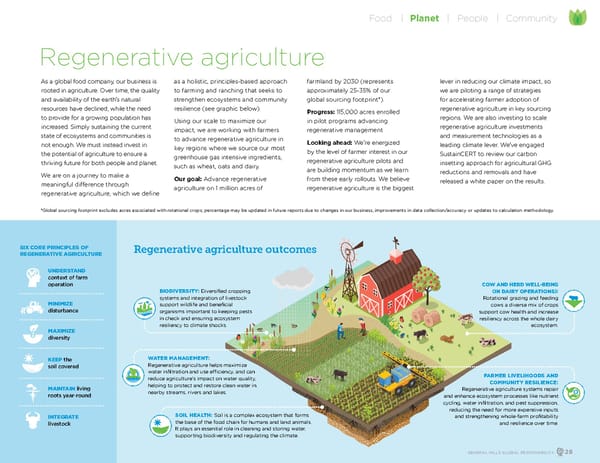As a global food company, our business is rooted in agriculture. Over time, the quality and availability of the earth’s natural resources have declined, while the need to provide for a growing population has increased. Simply sustaining the current state of ecosystems and communities is not enough. We must instead invest in the potential of agriculture to ensure a thriving future for both people and planet. We are on a journey to make a meaningful difference through regenerative agriculture, which we define as a holistic, principles-based approach to farming and ranching that seeks to strengthen ecosystems and community resilience (see graphic below). Using our scale to maximize our impact, we are working with farmers to advance regenerative agriculture in key regions where we source our most greenhouse gas intensive ingredients, such as wheat, oats and dairy. Our goal: Advance regenerative agriculture on 1 million acres of farmland by 2030 (represents approximately 25-35% of our global sourcing footprint*). Progress: 115,000 acres enrolled in pilot programs advancing regenerative management Looking ahead: We’re energized by the level of farmer interest in our regenerative agriculture pilots and are building momentum as we learn from these early rollouts. We believe regenerative agriculture is the biggest lever in reducing our climate impact, so we are piloting a range of strategies for accelerating farmer adoption of regenerative agriculture in key sourcing regions. We are also investing to scale regenerative agriculture investments and measurement technologies as a leading climate lever. We’ve engaged SustainCERT to review our carbon insetting approach for agricultural GHG reductions and removals and have released a white paper on the results. Regenerative agriculture SOIL HEALTH: Soil is a complex ecosystem that forms the base of the food chain for humans and land animals. It plays an essential role in cleaning and storing water, supporting biodiversity and regulating the climate. WATER MANAGEMENT: Regenerative agriculture helps maximize water infiltration and use efficiency, and can reduce agriculture’s impact on water quality, helping to protect and restore clean water in nearby streams, rivers and lakes. BIODIVERSITY: Diversified cropping systems and integration of livestock support wildlife and beneficial organisms important to keeping pests in check and ensuring ecosystem resiliency to climate shocks. COW AND HERD WELL-BEING ( IN DAIRY OPERATIONS ): Rotational grazing and feeding cows a diverse mix of crops support cow health and increase resiliency across the whole dairy ecosystem. SIX CORE PRINCIPLES OF REGENERATIVE AGRICULTURE UNDERSTAND context of farm operation MINIMIZE disturbance MAXIMIZE diversity KEEP the soil covered MAINTAIN living roots year-round INTEGRATE livestock FARMER LIVELIHOODS AND COMMUNITY RESILIENCE: Regenerative agriculture systems repair and enhance ecosystem processes like nutrient cycling, water infiltration, and pest suppression, reducing the need for more expensive inputs and strengthening whole-farm profitability and resilience over time. Regenerative agriculture outcomes *Global sourcing footprint excludes acres associated with rotational crops; percentage may be updated in future reports due to changes in our business, improvements in data collection/accuracy or updates to calculation methodology. GENERAL MILLS GLOBAL RESPONSIBILITY 28 Food Planet People Community
 GeneralMills Global Responsibility Report Page 29 Page 31
GeneralMills Global Responsibility Report Page 29 Page 31